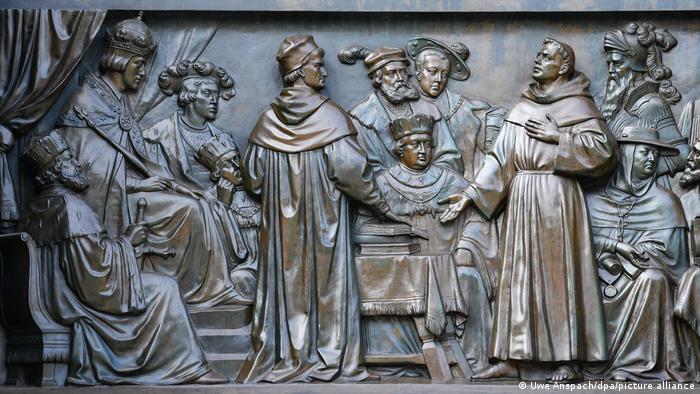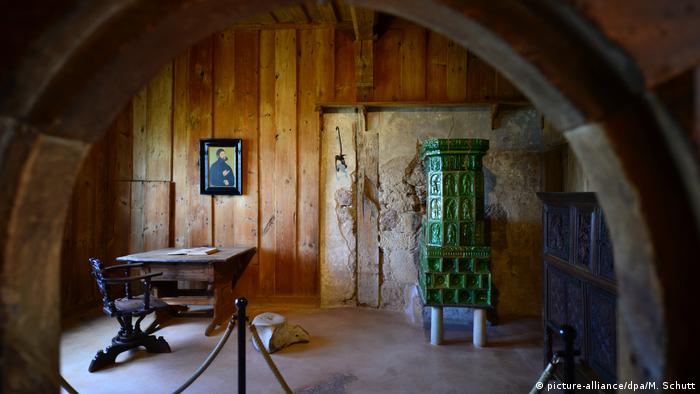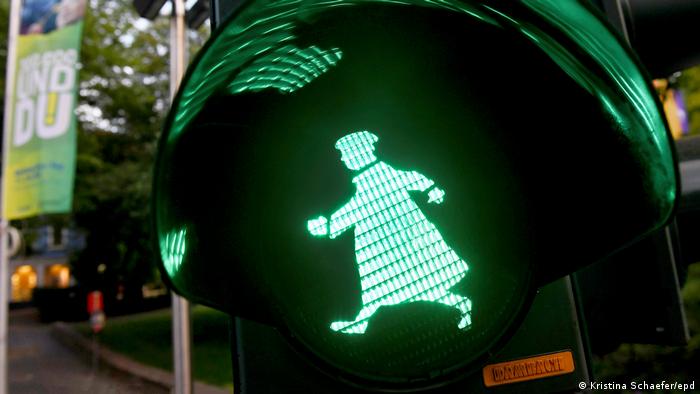A chance for ecumenical Christianity
The first major schism of the Catholic Church was made official in 1521. The pope excommunicated the initiator of the Reformation, Martin Luther. The monk had referred to the pontiff as the "Antichrist."

The German city of Worms is scheduled to become the setting for multimedia events throughout the year marking 'The Luther Moment'
The German city of Worms is preparing for a major centennial. To mark the 500th anniversary of Martin Luther's appearance at the Diet of Worms on the night of April 17/18 1521, the southern German town on the banks of the Rhine is planning an extensive commemorative program in conjunction with the Lutheran Church. More than 80 events are scheduled, despite COVID-19. The only item to fall victim to the pandemic so far is the central exhibition entitled "Hier stehe ich. Gewissen und Protest — 1521 bis 2021" (Here I Stand. Conscience and Protest — 1521 to Today), which was postponed from April to July.
The title is a reference to the words with which, according to popular legend, Luther concluded his defense at Worms: "Here I stand. I can do no other."
To mark these historic days of April 17 to 18, a church in Worms will become the setting for multimedia events throughout the year marking "The Luther Moment." The title is intended as a projection of key moments in everyday people's lives, a reflection of courage and integrity. This key moment in European history in mid-April 1521 continues to reverberate to this day, not least among Catholic and Protestant theologians.

This room in the Wartburg in Eisenach is where Martin Luther translated the New Testament into German
The first major schism of the Catholic Church was made official in 1521. The pope excommunicated the initiator of the Reformation, Martin Luther. The monk had referred to the pontiff as the "Antichrist."

The German city of Worms is scheduled to become the setting for multimedia events throughout the year marking 'The Luther Moment'
The German city of Worms is preparing for a major centennial. To mark the 500th anniversary of Martin Luther's appearance at the Diet of Worms on the night of April 17/18 1521, the southern German town on the banks of the Rhine is planning an extensive commemorative program in conjunction with the Lutheran Church. More than 80 events are scheduled, despite COVID-19. The only item to fall victim to the pandemic so far is the central exhibition entitled "Hier stehe ich. Gewissen und Protest — 1521 bis 2021" (Here I Stand. Conscience and Protest — 1521 to Today), which was postponed from April to July.
The title is a reference to the words with which, according to popular legend, Luther concluded his defense at Worms: "Here I stand. I can do no other."
To mark these historic days of April 17 to 18, a church in Worms will become the setting for multimedia events throughout the year marking "The Luther Moment." The title is intended as a projection of key moments in everyday people's lives, a reflection of courage and integrity. This key moment in European history in mid-April 1521 continues to reverberate to this day, not least among Catholic and Protestant theologians.

This room in the Wartburg in Eisenach is where Martin Luther translated the New Testament into German
The Church in crisis
It was in the early months of 1521 that the criticism of Martin Luther, an Augustinian monk born in Eisleben in the region of Wittenberg on the banks of the Elbe in 1483 — excoriating the Church practice of selling indulgences — resulted in a full-blown schism of Christianity in Germany. To this day, Christianity is marked by two central pillars of the dispute: On January 3, 1521, Pope Leo X issued a papal bull in Rome excommunicating Martin Luther and his supporters. Luther, for his part, had referred to the pope as the "Antichrist."
At the Diet of Worms, Luther was given an opportunity to recant his criticism of the pope and the synod in the presence of his contemporary political leaders. Yet, he risked his life by sticking to his criticism and escaped the following night while the deliberations continued, ultimately taking refuge in Wartburg Castle, near Eisenach.
Over the years, decades, and centuries, theologians of all Christian denominations have discussed and debated the schism. Many differences have been settled but the core divisions remain: The excommunication of Luther and his followers by the Catholic Church and the designation of the pope by Lutheran dogma as the "Antichrist."
Watch video 04:42 Luther in Eisenach and at Wartburg Castle
'The time is ripe'
In 2020, some 30 theologians who formed a group founded in 1999 calling itself the Altenberg Ecumenical Roundtable, presented a plea covering just a few pages: It called for a revocation of the excommunication bull by the pope and a statement that the allegations against Luther contained therein "do not apply to members of today's PfLinkrotestant and Lutheran Churches." In return, they called on the Lutheran World Federation to abolish Luther's designation of the pope as the Antichrist — on the grounds that it no longer applies to the current papacy and those who hold the office. "The time for this is ripe," read the appeal.
A recently published book about the schism features a historic image of the young Luther beside a photograph of a smiling Pope Francis. The book, entitled "In alle Ewigkeit verdammt?" (Damned for all eternity?) was edited by two members of the group, the Lutheran priest Hans-Georg Link (81), long-serving secretary of the Commission for Faith and Church Dogma in Geneva and Josef Wohlmuth (82), a retired theologian based in Bonn. They agree that "this burning point of contention still requires urgent treatment to this day, so that ecumenical faith can become a reality, hopefully not in the all-too-distant future."
The Altenberg Ecumenical Round Table calls on religious communities in Germany to take a stand, for example, through ecumenical services on the first weekend in January or joint prayers calling for divine intercession on behalf of reconciliation. And all this in the shadow of the COVID-19 pandemic.

The city of Worms you can find images of Luther everywhere
'Stand together for faith'
The pandemic, however, is not only getting in the way of ecumenical efforts. "In this year 2020, it once again became clear how important it is to take a stand for the joint faith in God made human through Christ, for neighborly love and the protection of the weak," said Thies Gundlach, one of the leading theologians of the Evangelical Church in Germany (EKD), in an interview with Deutsche Welle. He added, "We are grateful for the positive developments towards ecumenism between the Evangelical and Catholic churches, which have led to a deeper sense of community between them in recent years."
For Gundlach, the events surrounding the Diet of Worms "are of great relevance to Church history and the history of the Reformation. With regard to modern ecumenism, we are grateful that the disputes of the past have been overcome." He went on to say that the ecumenical movement had made great contributions to mutual understanding and reconciliation in recent years through constructive theological deliberations.

REBEL OR RUFFIAN: WHO WAS MARTIN LUTHER?
Luther with hammer and nails
Did Luther really nail his 95 theses to the main door of the Wittenberg Castle church? Reformation historians are still discussing this point 500 years later. In fact, Luther himself never mentioned the theses. Belgian historical painter Ferdinand Pauwels didn't seem to care - he painted Luther with hammer and nails anyway. PHOTOS 1234567
Hans-Georg Link, the Protestant priest who has devoted so many decades to ecumenism, warned, however: "Without eliminating the issues of the excommunication and the designation as Antichrist, a closer community between the Evangelical and Catholic churches is unthinkable. The year 2021, 500 years after the schism, would be a good juncture for officials on both sides to draw a line under the dispute."
The ball is now on both sides of the court at once. Both the pope in Rome and the Lutheran World Federation in Geneva must move toward each other. Meanwhile, in Germany, where it all began, the Churches are planning — to the extent that existing dogmatic regulations allow it — to hold a joint open-air service on Sunday, April 18, on the market square in Worms, under the motto "Here I Stand." The service will be led by the chair of the Council of the German Evangelical Church, Heinrich Bedford-Strohm, and the head of the German Catholic Bishops' Conference, Georg Bätzing.
This text was translated from German.
Jul 15, 2020 — The Peasant War in Germany was the first history book to assert that the real motivating force behind the Reformation and 16th-century peasant ...
DW RECOMMENDS
What Donald Trump and Reformer Martin Luther have in common
In the exhibition "From Luther to Twitter," Berlin's Deutsches Historisches Museum explores the connection between media and politics — from the printing press to social media.
How Martin Luther influenced Martin Luther King Jr.
That Martin Luther King Jr. bore the name of Martin Luther is the most obvious link between them. But the influence of the German reformer on the American civil rights leader was more profound than that.
Jewish heritage along the Rhine might be named a World Cultural Heritage
Speyer, Worms and Mainz, regarded as the cradle of Jewish life in Europe, were also known as "Jerusalem on the Rhine." The three cities are applying to UNESCO for the title World Cultural Heritage.
AUDIOS AND VIDEOS ON THE TOPIC
Wartburg Castle
Tracing Luther's footsteps in Thuringia
No comments:
Post a Comment